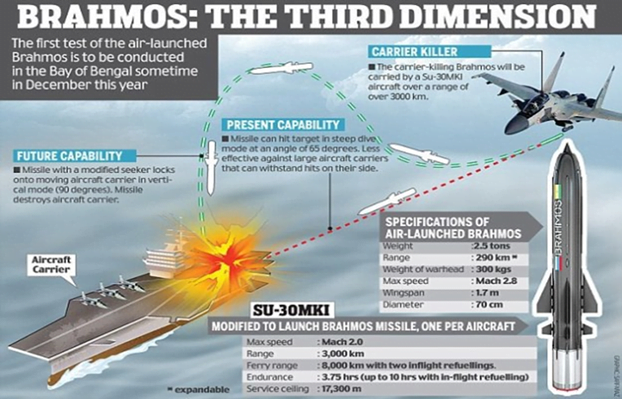Science and Technology
Context: The Defence Ministry signed a ₹1,700-crore contract with BrahMos Aerospace Pvt Ltd for 35 combat and three practice BrahMos supersonic surface-to-surface cruise missiles for two P-15B class of stealth guided missile destroyers of the Indian Navy.

About Brahmos:
- BrahMos is a joint venture between the DRDO and Russia’s NPO Mashinostroyeniya and the missile derives its name from Brahmaputra and Moskva rivers.
- On June 12, 2001, the BrahMos supersonic cruise missile was first tested from a land-based launcher in Chandipur.
- In the 21 years since, BrahMos has been upgraded several times, with versions tested on land, air, and sea platforms.
Background and development:
- Since the early 1980s, the Integrated Guided Missile Development Programme, conceived and led by Dr A P J Abdul Kalam, started developing a range of missiles including Prithvi, Agni, Trishul, Akash and Nag.
- An Inter-Governmental Agreement was signed with Russia in Moscow in 1998
- This led to the formation of BrahMos Aerospace, a joint venture between DRDO and NPO Mashinostroyenia (NPOM), the Indian side holding 50.5% and the Russians 49.5%.
- In 1999, work on development of missiles began in labs of DRDO and NPOM after BrahMos Aerospace received funds from the two governments.
- The first successful test in 2001 was conducted from a specially designed land-based launcher.
Strategic significance:
- BrahMos is a two-stage missile with a solid propellant booster engine.
- Its first stage brings the missile to supersonic speed and then gets separated.
- The liquid ramjet or the second stage then takes the missile closer to three times the speed of sound in cruise phase.
- The missile has a very low radar signature, making it stealthy, and can achieve a variety of trajectories.
- The ‘fire and forget’ type missile can achieve a cruising altitude of 15 km and a terminal altitude as low as 10 m to hit the target.
- Cruise missiles such as BrahMos, called “standoff range weapons”, are fired from a range far enough to allow the attacker to evade defensive counter-fire.
- The BrahMos has three times the speed, 2.5 times flight range and higher range compared to subsonic cruise missiles.
Versions deployed in all three-Armed forces are still being tested regularly:
LAND-BASED:
- The land-based BrahMos complex has four to six mobile autonomous launchers, each with three missiles on board that can be fired almost simultaneously.
- Batteries of the land-based systems have been deployed along India’s land borders in various theatres.
- The upgraded land attack version, with capability of cruising at 2.8 Mach, can hit targets at a range up to 400 km with precision.
- Advanced versions of higher range and speed up to 5 Mach are said to be under development.
- The ground systems of BrahMos are described as ‘tidy’ as they have very few components.
SHIP-BASED:
- The Navy began inducting BrahMos on its frontline warships from 2005.
- These have the capability to hit sea-based targets beyond the radar horizon.
- The Naval version has been successful in sea-to-sea and sea-to-land modes.
- The BrahMos can be launched as a single unit or in a salvo of up to eight missiles, separated by 2.5-second intervals.
- These can target a group of frigates with modern missile defence systems.
AIR-LAUNCHED:
- On November 22, 2017, BrahMos was successfully flight-tested for the first time from a Sukhoi-30MKI against a sea-based target in the Bay of Bengal.
- BrahMos-equipped Sukhoi-30s, which have a range of 1,500 km at a stretch without mid-air refuelling, are considered key strategic deterrence for adversaries both along land borders and in the strategically important Indian Ocean Region.
SUBMARINE-LAUNCHED:
- This version can be launched from around 50 m below the water surface.
- The canister-stored missile is launched vertically from the pressure hull of the submarine, and uses different settings for underwater and out-of-the-water flights.
- This version was successfully tested first in March 2013 from a submerged platform off the coast of Visakhapatnam.
Source: Indian Express
Previous Year Question
Q.1) Which one of the following statements best reflects the idea behind the “Fractional Orbital Bombardment System” often talked about in media? (2022)
- A hypersonic missile is launched into space to counter the asteroid approaching the Earth and explode it in space.
- A spacecraft lands on another planet after making several orbital motions.
- A missile is put into a stable orbit around the Earth and deorbits over a target on the Earth.
- A spacecraft moves along a comet with the same surface. speed and places a probe on its.
Q.2) With reference to India’s satellite launch vehicles, consider the following statements:
- PSLVs launch satellites useful for Earth resources monitoring whereas GSLVs are designed mainly to launch communication satellites.
- Satellites launched by PSLV appear to remain permanently fixed in the same position in the sky, as viewed from a particular location on Earth.
- GSLV Mk III is a four-staged launch vehicle with the first and third stages using solid rocket motors; and the second and fourth stages using liquid rocket engines.
Which of the statements given above is/are correct.? (2018)
- 1 only
- 2 and 3
- 1 and 2
- 3 only
Q.3) With reference to the Indian Regional Navigation Satellite System (IRNSS), consider the following statements : (2018)
- IRNSS has three satellites in geostationary and four satellites in geosynchronous orbits.
- IRNSS covers entire India and about 5500 sq. km beyond its borders.
- India will have its own satellite navigation system with full global coverage by the middle of 2019.
Which of the statements given above is/are correct?
- 1 only
- 1 and 2 only
- 2 and 3 only
- None














